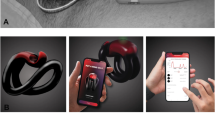Summary
In 26 patients with erectile impotence and 8 healthy volunteers the value of continuous monitoring of penile tumescence and rigidity by means of the RigiScan was tested. Based on history and routine screening tests the patients were divided into 3 groups of preliminary diagnosis: psychogenic (5 patients), organic (10 patients), mixed (11 patients). Real-time measurements of tumescence and rigidity were performed during direct visual stimulation and after intracorporeal injection of 80 mg papaverine hydrochloride according to a specific protocol. A total of 21 patients were monitored during sleep studies for 2 or 3 consecutive nights. The rigidity figures of the volunteers correlated well with their subjective interpretation of the erection. Evaluation of the recordings of the impotent patients enabled reclassification of the mixed group into 3 patients with mainly organic and 8 patients with mainly psychogenic impotence. RigiScan recording of penile tumescence and rigidity appears to be of great value in the diagnosis of impotent patients. Real-time monitoring during direct visual stimulation and after papaverine injection can generally replace nocturnal measurements. If the patient shows a positive response on visual sexual stimulation (VSS) alone, then his impotence is of psychogenic origin. Failing rigidity during VSS after injection indicates vascular impotence. In patients who show negative results during VSS alone, and positive response after injection or during subsequent VSS, nocturnal monitoring will differentiate between psychogenic and neurogenic impotence.
Similar content being viewed by others
References
Abber JC, Lue TF, Orvis BR, McClure RD, Williams RD (1986) Diagnostic tests for impotence: a comparison of papaverine injection with the penile-brachial index and nocturnal tumescence monitoring. J Urol 135:923–925
Barry JM, Blank B, Boileau M (1980) Nocturnal penile tumescence monitoring with stamps. Urology 15:171–172
Bohlen JG (1981) Sleep erection monitoring in the evaluation of male erectile failure. Urol Clin North Am 8:119–134
Bradley WE, Timm GW, Gallagher JM, Johnson BK (1985) New method for continuous measurement of nocturnal penile tumescence and rigidity. Urology 26:4–9
Buvat J, Buvat-Herbaut M, Dehaene JL, Lemaire A (1986) Is intracavernous injection of Papaverine a reliable screening test for vascular impotence? J Urol 135:476–478
Condra M, Morales A, Surridge DH, Owen JA, Marshall P, Fenemore J (1986) The unreliability of nocturnal penile tumescence recording as an outcome measurement in the treatment of organic impotence. J Urol 135:280–282
Dacomed Corporation, Minneapolis, Minnesota, USA (1986) RigiScan® ambulatory rigidity and tumescence system. Selected case studies. Form number 7501560486
Ek A, Bradley WE, Krane RJ (1983) Nocturnal penile rigidity measured by the snap-gauge band. J Urol 129:964–966
Hengeveld MW (1986) Erectile dysfunction: diagnosis and choice of therapy. World J Urol 3:249–252
Jonas U (1982) Erektiometer®: Ein einfacher und sicherer Test in der Diagnostik der erektilen Impotenz. Akt Urol 13:324–327
Kaneko S, Bradley WE (1986) Evaluation of erectile dysfunction with continuous monitoring of penile rigidity. J Urol 136:1026–1029
Karacan I, Salis PJ, Williams RL (1978) The role of the sleep laboratory in the diagnosis and treatment of impotence. In: Williams RL, Karacan I, Frazier SH (eds) Sleep disorders: diagnosis and treatment. John Wiley and Sons, New York
Marshall P, Morales A, Surridge D (1981) Unreliability of nocturnal penile tumescence recording and MMPI profiles in assessment of impotence. Urology 17:136–139
Metz P, Wagner G (1981) Penile circumference and erection. Urology 18:268–270
Pressman MR, DiPhillipo MA, Kendrick JI, Conroy K, Fry JM (1986) Problems in interpretation of nocturnal penile tumescence studies: disruption of sleep by occult sleep disorders. J Urol 136:595–598
Sidi AA, Lange PH (1986) Recent advances in the diagnosis and management of impotence. Urol Clin North [Am] 13:489–500
Virag R (1982) Intracavernous injection of Papaverine for erectile failure. Lancet 2:938
Virag R, Frydman D, Legman M, Virag H (1984) Intracavernous injection of Papaverine as a diagnostic and therapeutic method in erectile failure. Angiology 79–87
Wein AJ, Fishkin R, Carpiniello VL, Malloy TR (1981) Expansion without significant rigidity during nocturnal penile tumescence testing: a potential source of misinterpretation. J Urol 126:343–344
Wein AJ, Arsdalen KV, Malloy TR (1983) Nocturnal penile tumescence. In: Krane RJ, Siroky MB, Goldstein I (eds) Male sexual dysfunction. Little, Brown and Co, Boston
Wespes E, Schulman CC (1984) Parameters of erection. Brit J Urol 56:416–417
Zorgniotti AW, Lefleur RS (1985) Auto-injection of the corpus cavernosum with a vasocactive drug combination for vasculogenic impotence. J Urol 133:39–41
Author information
Authors and Affiliations
Rights and permissions
About this article
Cite this article
Giesbers, A.A.G.M., Bruins, J.L., Kramer, A.E.J.L. et al. New methods in the diagnosis of impotence: RigiScan® penile tumescence and rigidity monitoring and diagnostic papaverine hydrochloride injection. World J Urol 5, 173–176 (1987). https://doi.org/10.1007/BF00326827
Issue Date:
DOI: https://doi.org/10.1007/BF00326827




